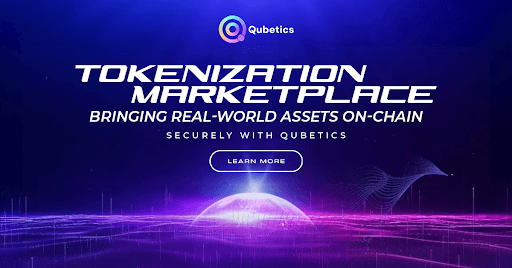The race for blockchain dominance in 2026 is heating up, and Stellar Lumens (XLM) seems to be gathering momentum. Backed by an established history in cross-border payments and an increasingly favorable chart setup, Stellar’s long-term bullish case is now clearer than ever. According to InvestingHaven, the cryptocurrency could see prices ranging between $0.71 and $1.44 next year—potentially fueled by broader adoption of decentralized financial systems and strong institutional interest.
But the spotlight isn’t shining solely on Stellar. Qubetics, a rising force in the Web3 ecosystem, is executing on a bold, high-utility vision. With real-world asset (RWA) tokenisation at its core and a rapidly growing community, Qubetics is quietly laying the groundwork to become a foundational layer in future blockchain finance. While Stellar aims to reaffirm its leadership in international payments, Qubetics is aggressively building cross-chain utility to bring tokenised real estate, commodities, and equities into everyday digital infrastructure.
Could 2026 be the year the old guard and the new wave meet at the top?
The Bullish Reversal in Motion: Stellar’s 2026 Setup
Stellar has long stood as a protocol purpose-built for borderless payments and digital currency transfers. Since its launch in 2014, XLM has steadily evolved, partnering with major financial institutions and enabling low-fee, high-speed transfers globally. What makes 2026 particularly interesting for XLM is the validation of its long-standing bullish chart structure.
Currently, Stellar is showing signs of a giant cup-and-handle reversal—a pattern that, once fully formed, often leads to major price breakthroughs. Analysts from InvestingHaven maintain that if XLM can hold above key Fibonacci levels like $0.375 and break above $0.71 with sustained volume, the price could test—and even exceed—the $1.44 mark. That breakout would signify a return to levels not seen since the bull market of 2021.
Beyond the technicals, real-world adoption is expected to play a huge role. Stellar’s partnerships with fintech platforms, global remittance providers, and stablecoin issuers continue to expand. With global interest in decentralized cross-border payments growing, XLM’s foundational role may finally be priced in.
However, some analysts caution that if XLM drops below its $0.30 support zone, it could re-enter a prolonged accumulation phase. The upside, though, remains enticing—especially if crypto markets broadly recover and the Stellar Development Foundation’s institutional onboarding continues.
Stellar’s Institutional Push and the DeFi Factor
What separates Stellar from many altcoins is its laser focus on interoperability and regulatory-aligned finance. The project isn’t gunning for hype. Instead, it’s positioning itself as a compliant infrastructure partner for central banks and fintech firms.
A key turning point was the integration of Stellar with payment processors and remittance platforms operating in South America and Africa. These moves positioned XLM as a direct challenger to SWIFT in select corridors. Moreover, the coin’s volatility remains relatively moderate, making it a more predictable choice for institutions.
In 2026, if these partnerships scale—and especially if a central bank digital currency (CBDC) rides on Stellar rails—XLM could rally much faster than most are anticipating. DeFi use cases on Stellar are also expected to grow, especially as liquidity bridges to other networks mature. All eyes are now on whether XLM can convert utility into significant market share during what could be another bullish phase for the crypto market.
Qubetics: A Real-World Asset Tokenisation Marketplace Ready for Prime Time
While Stellar captures headlines for its decade-long tenure and payment focus, Qubetics is fast becoming the go-to name in real-world asset (RWA) tokenisation—a trend many believe will dominate the next cycle. As the first Web3 aggregator uniting major blockchains, Qubetics offers a uniquely interoperable platform designed for high-utility tokenisation across real estate, equities, commodities, and more.
At the center of this growing ecosystem is Qubetics’ Real World Asset Tokenisation Marketplace. Unlike legacy platforms, Qubetics doesn’t rely on siloed chains or clunky interfaces. Instead, its architecture facilitates seamless asset minting, fractionalization, and liquidity provisioning across multiple chains—all from one unified interface. This isn’t theory. Early demos have already shown tokenised real estate assets trading across Solana, Ethereum, and BNB Chain environments with minimal friction.
For traditional asset managers and crypto-native builders alike, Qubetics offers a clean path to bring off-chain value on-chain. Whether it’s a private REIT looking to tokenize its fund or a local SME aiming to raise capital via tokenised debt, the platform offers the rails and compliance tools to do so efficiently. With growing momentum in the tokenisation sector and validation from legacy players like BlackRock, Qubetics could become a first-mover giant.

Qubetics Presale Outlook: Undervalued, or Just Misunderstood?
Currently in its 35th stage, the Qubetics presale has already raised over $17.3 million, selling more than 513 million $TICS tokens to over 26,900 early adopters. At a current price of $0.2785, the numbers suggest that many see Qubetics as more than another Layer-1 or DeFi play. They see utility, and more importantly—scalability.
Let’s break it down. A $100 allocation at today’s rate could yield 358.95 tokens. If $TICS hits $1 post-launch, that translates to a 258.95% ROI. Now extend that: $5 yields 1,694.74%, $10 leads to 3,489.47%, and $15 unlocks a staggering 5,284.21% return. These aren’t made-up figures—they’re grounded in the tokenomics and platform trajectory that’s been outlined ahead of Qubetics’ mainnet launch in Q2 2025.
Participants in this presale aren’t just speculating. They’re placing strategic bets on a project that could capture the lion’s share of Web3’s next frontier: real-world asset tokenisation. With most presale stages lasting only 7 days and prices increasing 10% weekly, many are racing against the clock.
Conclusion: Old Guards Rise, But New Builders May Lead
As Stellar eyes $1.44 in 2026 and attempts to reclaim dominance in the decentralized finance landscape, it’s clear that the project still commands attention, especially among cross-border payment enthusiasts. But while XLM has longevity and partnerships, Qubetics may hold the wildcard advantage—especially with its cross-chain, real-world asset utility now turning heads.
With nearly all major analysts bullish on tokenisation as the next big trend and institutions actively scouting compliant ecosystems, Qubetics is building the rails that could support the financial future others are only theorizing about.
As always, due diligence remains critical, but for those scanning beyond surface-level hype and into infrastructure-grade utility, the Qubetics presale might just be the “best crypto presale” to monitor before the next phase of market maturity.
For More Information:
Qubetics: https://qubetics.com
Presale: https://buy.qubetics.com/
Telegram: https://t.me/qubetics
Twitter: https://x.com/qubetics




